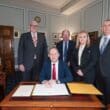Armagh Observatory has got some New-Year cheer following an announcement by the UK Science and Technology Facilities Council (STFC) of a new three-year grant amounting to more than £500,000 pounds.
The Principal Investigator of the grant, Professor Gerry Doyle, says that the Observatory’s research programme focuses on projects in which the Observatory has a recognised international leadership role in addressing key science priorities identified by recent Programmatic Review of the STFC’s Astronomy and Solar System Advisory Panels.
The main research interests of Observatory staff are focused on the Solar System, the Sun itself, and the properties and life cycles of other Stars, including the role of stars as tracers for our understanding of the wider Universe.
One project funded by the new grant will study the evolution of stars that collide or merge with other stars. In this case, Professor Simon Jeffery’s team will study the results of mergers between very old stars, or white dwarfs.
Such mergers can produce a more massive star with a new life of its own — a star re-born — becoming one of the most exotic stars in the Galaxy, or it may result in a gigantic explosion called a supernova.
These rare events can be used to probe the most distant parts of the Universe.
Another project will investigate how to test models of the early evolution of our solar system using studies of groups of asteroids called “Trojans”, which orbit at the same average distance from the Sun as one or another of the main planets.
This work, led by Dr Apostolos Christou, will shed new light on processes affecting the physical and dynamical evolution of
near-Earth asteroids, that is, asteroids that might collide with Earth.
The rare Martian Trojans are particularly useful for this work, as they have similar sizes (several hundred metres to several kilometres across) to those of many observed near-Earth asteroids, but their long-term evolution is not significantly affected by planetary encounters.



